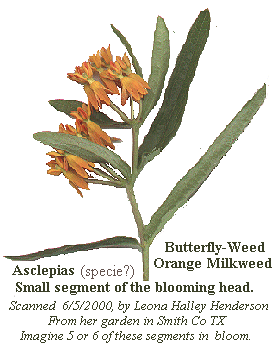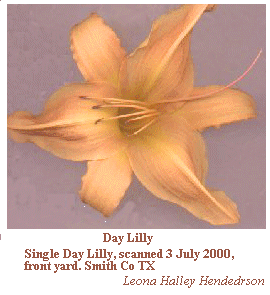 Actual colors somewhat brighter. I have white, yellow and cinnamon but they are available in other colors as well.
Actual colors somewhat brighter. I have white, yellow and cinnamon but they are available in other colors as well.
The blossoms are similar to queens lace but not quite as airy; more compact. They are members of the compositae like Wormwood and Camomile and have the same medicinal qualities.
2 teaspoons of dried Yarrow leaves steeped in a cup of boiling water is said to ease muscles spasms and relieve inflamation. Perhaps helpful to alleviate some of the discomfort of Reumatoid Arthritis as well as tendenitis, etc. If you are using fresh leaves as I usually do, use twice the amount as they are a lot bulkier than when dried.
Yarrow grows wild in some areas, however, it is probably easier to buy a cultivar from the nursery or get a start of the roots or some seed from a friend.
BUTTERFLY WEED
 I particularly like the Butterfly milk weed (Asclepias species??).
I have been advised by various gardeners on the News Group, rec.gardens, that this plant is not an Aclepias 'tuberosa' as the tuberosa has a long tap root rather than a tuber which is what this looks like. There are so many species that it gets pretty confusing.
This particular plant grows wild in some parts of Texas, but a cultivar of various shades of red to yellow can be found in some seed catalogs. The ones wild in our area have rather light orange bloom clusters
atop stalks covered with about 1 1/2 inch long, slender grayish green
alternate leaves. The sap of this plant is not as milky as most milk-weeds, very, very little in fact.
I particularly like the Butterfly milk weed (Asclepias species??).
I have been advised by various gardeners on the News Group, rec.gardens, that this plant is not an Aclepias 'tuberosa' as the tuberosa has a long tap root rather than a tuber which is what this looks like. There are so many species that it gets pretty confusing.
This particular plant grows wild in some parts of Texas, but a cultivar of various shades of red to yellow can be found in some seed catalogs. The ones wild in our area have rather light orange bloom clusters
atop stalks covered with about 1 1/2 inch long, slender grayish green
alternate leaves. The sap of this plant is not as milky as most milk-weeds, very, very little in fact.
5-21-96 update...I found some plants at our nursery! Pat had ordered the seeds from somewhere and planted a flat of them. I got 4 of the little plants!
Just hope I don't kill them with kindness! And...hope there will be enough sun where I put them.!!
I've read that the mature plant contains a chemical, 'Asclepian' which is a meat
tenderizer. You put a small sprig in with the stewing meat to cook
and tenderize it then remove it before serving.
Native Americans, so I am told, used the fluff from the seeds
added to the dried inner bark of cedars (1/3 fluff and 2/3 cedar)
to make fire bow tinder.
LIKE POKE WEED, ALL PARTS OF THE PLANT ARE TOXIC UNLESS PAR-BOILED FIRST. It blooms in the summer, but parts of the plant are usable
spring and summer. All parts are edible after beig parboiled: roots, flower buds, flowers,
and young seed pods. The plant is high in ascorbic acid. DO NOT EAT
ANY PART OF THE PLANT RAW. Like the South's POKE WEED, the flowers,
buds, and pods must be boiled for 12-15 minutes, drained then boiled
again. Do this 2 or 3 times. The pods should be picked before they
become too elastic. The roots should be boiled 30 minutes, pouring
off the water several times. Put a pinch or two of baking soda in the
water while boiling.
The flowers can be dipped in boiling water for about 1 minute
then dipped in pancake batter and fried like fritters and eaten
moderately.
 |
DAY LILLIES
The blossoms at the top of the page are also day lillies. The blooms
of these can be prepared and eaten just like the blossoms of the
milkweed above. The flower buds are particularly good before they
open. These day lily buds can be used in a greens salad. |
![[ rainbow bar ]](pic/rbbar.gif)
|
![[ day lily ]](pic/lileft.gif) HERBS & OTHER PLANTS
HERBS & OTHER PLANTS![[ day lily ]](pic/lill.gif)
![[ day lily ]](pic/lileft.gif) HERBS & OTHER PLANTS
HERBS & OTHER PLANTS![[ day lily ]](pic/lill.gif)
 Actual colors somewhat brighter. I have white, yellow and cinnamon but they are available in other colors as well.
Actual colors somewhat brighter. I have white, yellow and cinnamon but they are available in other colors as well. 